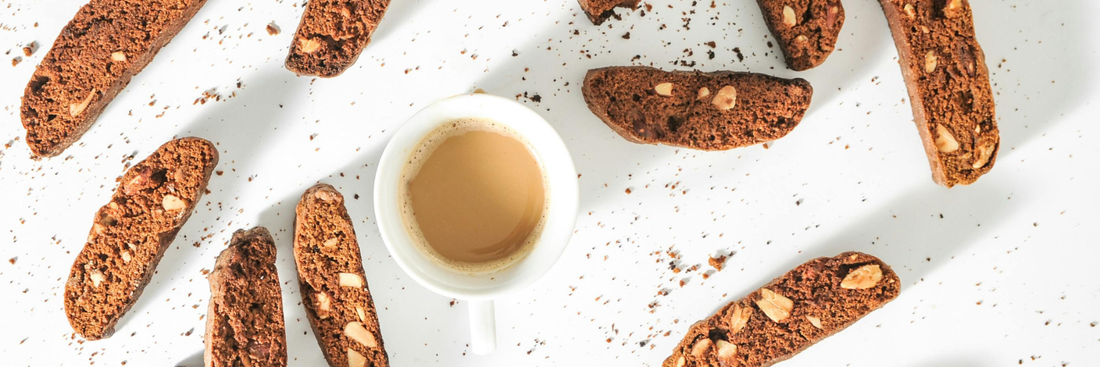If you’ve ever enjoyed a crunchy cookie perfect for dipping into coffee, it was likely a biscotti. Biscotti are traditional Italian cookies baked twice (twice-baked), which gives them their signature crisp texture and long shelf life.
The term comes from Latin bis-coctus, meaning “twice baked.” Biscotti are ideal as a snack, dessert, or even a gift, and are increasingly popular in cafés, bakeries, and retail settings that value premium presentation.
-
50 Different Types of Cookies: The Ultimate Cookie Lover’s Guide
-
How Long Cookies Last? What Every First-Time Baker Should Know
-
Tahini Cookies Recipe: Chewy, Nutty, & Naturally Gluten-Free Friendly
History & Origins of Biscotti

- Biscotti originated in Tuscany, particularly in the city of Prato, where they are called biscotti di Prato or cantucci.
- Traditionally, biscotti were used as long-lasting travel food because their dry texture prevented spoilage.
- In modern times, flavors like chocolate, fruit, and nuts have boosted biscotti’s popularity worldwide.
Biscotti Structure & Baking Science
Classic Ingredients
Traditional biscotti usually contain:
- Flour
- Sugar
- Eggs
- Almonds or pine nuts
- Optional flavors: anise, vanilla, almond extract
Some recipes use no butter or oil, keeping the texture crisp.
Two-Step Baking Process
- First bake: Shape dough into a log and bake until firm.
- Slice and second bake: Slice the baked log and bake again at lower temperature until dry and crisp.
This second bake removes moisture, creating the classic crunchy texture and extending shelf life.
Types & Variations of Biscotti

- Classic Almond Biscotti / Cantucci: Traditional Tuscan almond cookies.
- Double Chocolate Biscotti: Rich chocolate biscotti popular in modern cafés.
- Cranberry-Pistachio Biscotti & Citrus Biscotti: Fruity variations for holiday gifts or snacks.
- Gluten Free Biscotti: Uses almond or oat flour for gluten-intolerant customers.
- Vegan Biscotti: Replaces eggs with flax egg or aquafaba for plant-based diets.
Regional variations exist, such as tozzetti in Lazio.
Classic Almond Biscotti Recipe (How to Make Biscotti)
Ingredients
- 2 cups all-purpose flour
- ¾ cup sugar
- 2 large eggs (room temperature)
- 1 tsp almond extract
- 1 tsp baking powder
- 1 cup whole almonds, roasted or raw
- Optional: ½ tsp salt
Instructions
- Preheat oven to 350°F (175°C). Line baking sheet with parchment.
- In a large bowl, beat eggs and sugar until smooth; add almond extract.
- Sift flour, baking powder, and salt; mix into egg mixture. Fold in almonds.
- Divide dough into two logs, shape oblong, 2–3 cm thick.
- First bake 25–30 min until lightly golden.
- Cool 10–15 min, slice into 1–1.5 cm slices.
- Arrange slices on baking sheet; bake 10–15 min per side until dry and crisp.
- Cool completely on a wire rack before storing in airtight container.
Tips & Storage
- Slice with serrated knife for even pieces.
- Store in airtight containers; lasts for weeks.
- Perfect for dunking in coffee, tea, or dessert wine.
Flavor Ideas & Serving Suggestions

- Espresso or cappuccino: Classic pairing.
- Tea or milk: Gentle alternative.
- Dessert wine: Traditional pairing for special occasions.
- Holiday gifts: Cranberry-pistachio or chocolate varieties are ideal for packaging and gifting.
Biscotti in Business & Retail
- Premium biscotti packaging preserves crispness and adds gift appeal.
- Trend: gluten free, vegan, chocolate, and fruit-flavored biscotti are in high demand.
- Packaging solutions should be eco-friendly (kraft paper, recyclable PET, biodegradable window bags).
Nutrition & Special Diets
- Calorie content varies depending on sugar and nuts.
- Gluten free biscotti: Almond or oat flour with nuts and dried fruits.
- Vegan biscotti: Egg replacers like flax egg or aquafaba.
- Include labeling for allergens, gluten-free, vegan, and natural ingredients.

Troubleshooting Common Issues
- Too hard: Overbaked second time; reduce time or temperature.
- Too soft: Not fully dried; bake a few more minutes.
- Crumbly: Dough too loose or slices cut too early; chill logs and slice with serrated knife.
- Uneven flavor: Mix nuts and fruits evenly throughout the dough.
FAQ – Biscotti
Q1: What is biscotti?
Twice-baked Italian cookies, oblong and crunchy, often with almonds.
Q2: Why are biscotti hard?
Second bake removes moisture, giving them crisp texture.
Q3: How do you eat biscotti?
Quick dunk into coffee, tea, or dessert wine.
Q4: Are biscotti and cantucci the same?
Cantucci is the traditional almond biscotti from Tuscany; biscotti is a broader term.
Q5: How long do biscotti last?
Stored airtight, can last several weeks.
Q6: Can biscotti be gluten-free or vegan?
Yes – recipes exist using almond/oat flour and egg substitutes.
Conclusion
Biscotti remain a timeless Italian treat, adaptable for modern tastes: from almond biscotti recipe to double chocolate biscotti, to gluten free biscotti. For businesses and cafés, combining biscotti with premium eco-friendly packaging enhances customer experience and brand sustainability. Incorporate secondary keywords naturally to maximize organic reach and capture diverse search intent.







